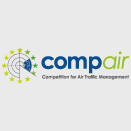

Single European Sky ATM Research (SESAR) is a collaborative project to completely overhaul European airspace and its air traffic management (ATM). The actual programme is managed by the SESAR Joint Undertaking as a public–private partnership (PPP).
In the 20th century, unlike United States, Europe did not have a single civilian airspace — i.e., one in which air navigation is managed at the European level. Furthermore, European airspace is among the busiest in the world with over 33,000 flights daily and airport density in Europe is very high. This makes air traffic control more complex. The EU Single European Sky (SES) legislature was drawn to overcome the air control management's fragmentation and flight capacity limitation by structuring airspace and air navigation services at a pan-European level. To develop the needed technological capacity, the SESAR programme was initiated in 2004 as a continuation of a smaller effort by Eurocontrol, SESAME-project. In June 2010, European and American authorities reached a preliminary agreement on interoperability between their future air traffic management systems, SESAR and NextGen.
The SESAR project is composed of three phases:
SESAR’s target concept relies on a number of new key features:
The SESAR project has a parallel in the NextGen project within the United States.
For more information please visit this link.

Air transport is facing many challenges such as increasing demand, larger airports, increased network congestion, etc. which also need to be reconciled with environmental issues. Hence there is a need for smarter solutions at service, operational and technical level.... Read more...

BEST is SESAR Exploratory Research project focusing on a new way of data handling. By creating new data classification methodologies it will enable the application of System Wide Information Management (SWIM) one of the main results of SESAR. BEST will determine how semantic technologies can be used... Read more...